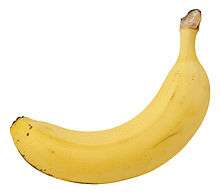Latundan banana
| Musa 'Silk' | |
|---|---|
 Apple bananas | |
| Hybrid parentage | Musa acuminata × Musa balbisiana |
| Cultivar group | AAB Group (Pome Group) |
| Cultivar | 'Silk' |
| Origin | Philippines |
Latundan bananas (also called Tundan, silk bananas, Pisang raja sereh, Manzana bananas or apple bananas), are triploid hybrid banana cultivars from the Philippines. It is one of the most common banana cultivars in Southeast Asia and the Philippines, along with the Lacatan and Saba bananas.[1]
Description
Latundan banana plants typically reach a height of 10 to 13 feet. They require full or partial sun exposure. The flowers are yellow, purple, or ivory in color. The fruits are round-tipped with thin yellow skin that splits once fully ripe. They are smaller than the Lacatan cultivar and the commercially dominant Cavendish bananas.[2][3] They have a slightly acidic, apple-like flavor.[4]
Taxonomy
In older classifications, the Latundan cultivar was once the plant referred to as Musa sapientum. It has since been discovered that Musa sapientum is actually a hybrid cultivar of the wild seeded bananas Musa balbisiana and Musa acuminata and not a species.[5]
The Latundan banana is a triploid (AAB) hybrid.[6]
Its full name is Musa acuminata × M. balbisiana (AAB Group) 'Silk'.
Uses
Latundan bananas are popular dessert bananas. They are also cultivated as ornamental plants.
Diseases
See also
References
- ↑ Hautea, D.M., G.C. Molina, C.H. Balatero, N.B. Coronado, E.B. Perez, M.T.H. Alvarez, A.O. Canama, R.H. Akuba, R.B. Quilloy, R.B. Frankie, C.S. Caspillo (2002-07-19). "Analysis of induced mutants of Philippine bananas with molecular markers". Institute of Plant Breeding, College of Agriculture, University of the Philippines Los Baños, FAO Corporate Document Repository. Retrieved 12 January 2011.
- ↑ "Lacatan, Latundan & Senorita bananas". marketmanila.com. March 8, 2007. Retrieved 13 January 2011.
- ↑ "BANANA". Philippine Department of Agriculture. March 8, 2007. Archived from the original on 26 June 2003. Retrieved 13 January 2011.
- ↑ "Musa 'Silk', AAB Group". learn2grow.com. Retrieved 11 January 2011.
- ↑ "Musa sapientum". users.globalnet.co.uk. Retrieved 11 January 2011.
- ↑ Michel H. Porcher; Prof. Snow Barlow (2002-07-19). "Sorting Musa names". The University of Melbourne. Retrieved 11 January 2011.
